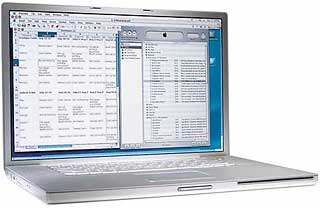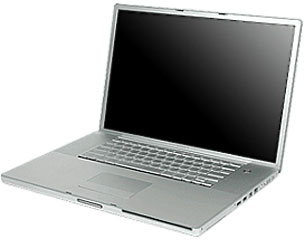For the past several years, I've been recommending the 12" aluminum PowerBook as a best buy in a
low-end Apple laptop with enough muscle to still serve as a workhorse
computer. Prices for used 12-inchers
have dropped into the $400 to $650 range depending upon model and
condition, which makes these machines a relative bargain, and they are
still the only comprehensively-featured, reasonably modern subnotebook
Macs, given the MacBook
Air's manifold compromises and deficiencies as a serious work
platform and the lack of FireWire support in the new Unibody 13" MacBooks. All 12"
PowerBooks are supported by Mac OS X 10.5 "Leopard" (although the
early 867 MHz model
only by the skin of its proverbial teeth).

However, if you have a few more dollars to spend and/or are less
interested in light weight and compact dimensions for easy carrying as
opposed to desktop substitute priorities, the larger aluminum
PowerBooks are worthy of consideration too. Prices for both 15" and 17" PowerBooks have now
dropped well below $1,000, making them an attractive option for the
budget-minded notebook user.
Personal Experience
I'm speaking empirically here. Thirty-three months ago, I bought a
1.33 GHz 17" PowerBook
G4 to replace a G3
iBook as my main production computer, and I haven't regretted it
for a moment. The 17-incher, an Apple Certified Refurbished unit
acquired from
TechRestore, has been both flawlessly reliable and a delight to
use. It's close to marginal for some tasks running Leopard, but still
falling on the acceptable side of the margin in my estimation.
While I'm not smitten with its trackpad response and would prefer
that the cooling fans ran less frequently, that's pretty much it for
complaints. It's been a better machine than I had dared hope, and while
it's bulkier and heavier than the old 12" iBook or a 12" PowerBook,
I've found it quite reasonable to lug around on road trips or use in
the car parked outside the local (24 mile round trip) library, whose
WiFi hotspot is my only reasonable access to broadband in this neck of
the woods.
 I'm not quite a widescreen junkie, but I'm more of one than I
once was. Although I'm still fairly content working on the 1024 x 768
Super VGA display in my old Pismo PowerBooks, having the
extra screen real estate on the BigAl is no hardship, and truth to tell
I would miss it - at least the 1440 x 900 resolution, which is matched
by the late-revision 15"
PowerBooks and the 15" MacBook Pro.
I'm not quite a widescreen junkie, but I'm more of one than I
once was. Although I'm still fairly content working on the 1024 x 768
Super VGA display in my old Pismo PowerBooks, having the
extra screen real estate on the BigAl is no hardship, and truth to tell
I would miss it - at least the 1440 x 900 resolution, which is matched
by the late-revision 15"
PowerBooks and the 15" MacBook Pro.
Features and Reliability
From statistical reports I've seen, the 17-inch 'Books (both
PowerBook and MacBook Pro) are among the most reliable recent Apple
portables, and my own experience doesn't contradict this. I expect that
having more space to accommodate and cool the internal bits helps, and
perhaps Apple applies just a bit more rigorous quality control to its
flagship models, although that is just a deductive surmise on my
part.
However, one fact about buying a top-of-the-line unit is that you
get the most comprehensive package of features that Apple chose to
offer at the time of manufacture - all the bells and whistles that
usually take a while to filter down to more prosaic Mac hardware.
Value and Benefits
A good analogy is buying a used Cadillac or Lexus as opposed to a
brand-new econo-box. I had a neighbor who always drove older Caddys. He
would chuckle about people who would tell him, "It must be nice to be
able to afford a car like that," then hop into their new Toyota or
Honda that had cost two or three times as much as he'd paid for his
used Cadillac.
 While I could have bought a
new MacBook a few months later for what I paid for the 17" PowerBook in
February, 2006, I wouldn't have a backlit keyboard or a PC Card slot or
FireWire 800 (missing from the original 15" MacBook
Pro) or the cachet and swish looks of the BigAl.
While I could have bought a
new MacBook a few months later for what I paid for the 17" PowerBook in
February, 2006, I wouldn't have a backlit keyboard or a PC Card slot or
FireWire 800 (missing from the original 15" MacBook
Pro) or the cachet and swish looks of the BigAl.
I also wouldn't have a built-in modem or Classic Mode support (in
Mac OS X 10.4 "Tiger", which I still have installed on one of the
17-incher's hard drive partitions, although I have to concede that it's
been nearly a year since I booted into Tiger on this machine).
While Apple sometimes has Certified Refurbished (ACR)
MacBooks listed as low as $750 to $800, and anyone shopping in this
price range should seriously consider an ACR MacBook as a pretty
awesome value in terms of cost/performance, there's still a case to be
made for a PowerPC 'Book for a while yet - especially one of the
last-revision 1.5 GHz or 1.67 GHz models.
It's certainly an alternative that has worked out splendidly for me,
and with a bit of tweaking.
For example, Wegener Media currently
offers the first four models of 17" PowerBooks with a 60 day warranty,
spanning a price spectrum of just $110:
- 17" PowerBook G4/1 GHz, 512 MB RAM/60 GB hard drive/SuperDrive,
$789.99
- 17" PowerBook G4/1.33 GHz, 512 MB RAM/80 GB hard drive/SuperDrive,
$829.99
- 17" PowerBook G4/1.5 GHz, 1 GB RAM/100 GB hard drive/SuperDrive,
$859.99
- 17" PowerBook G4/1.67 GHz, 1 GB RAM/100 GB hard drive/SuperDrive,
$899.99
PowerBooks of all sizes are thinning out somewhat in the used channels, but
you can certainly find others with a bit of digging, perhaps on
eBay if you like auction-buying.
So which is the best 17" PowerBook pick as a low-end machine? The
easy answer would be the
last-revision 1.67 GHz model with the high-definition display, and
that's the one I would recommend if your budget is amenable, although I
again would be remiss if I didn't suggest also considering a refurb.
MacBook in this price range.
In lower-priced models, I'm extremely pleased with the service and
performance I'm getting with my 1.33 GHz 17-incher, and I've never
heard anything bad about the original 1 GHz model. All
the 17-inchers seem to have been pretty solid and reliable machines in
general, although as with any mass-produced product, especially one as
complex as a portable computer, there will inevitably have been the odd
lemon, I suppose.
For more information on the BigAl PowerBooks, see
Low End Mac's
Compleat Guide to the 17" PowerBook.


 I'm not quite a widescreen junkie, but I'm more of one than I
once was. Although I'm still fairly content working on the 1024 x 768
Super VGA display in my old
I'm not quite a widescreen junkie, but I'm more of one than I
once was. Although I'm still fairly content working on the 1024 x 768
Super VGA display in my old 
